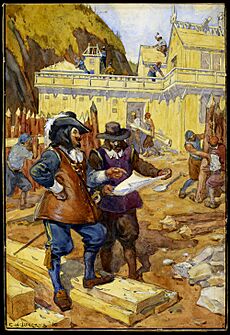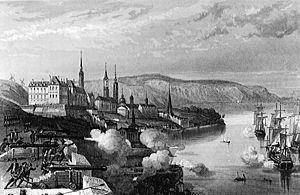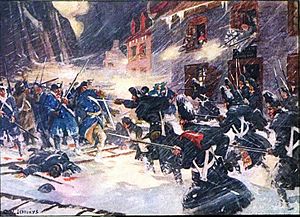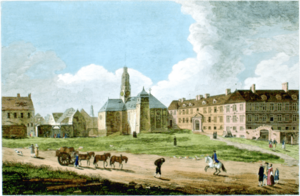History of Quebec City facts for kids
The history of Quebec City goes back thousands of years. The first people to live here were the First Nations groups. Later, French explorers arrived in the 1500s. This led to the founding of Quebec City in what is now Quebec, Canada. The city is one of the oldest European settlements in North America. A permanent trading post was set up in 1608.
Contents
French Rule in Quebec City
A French explorer named Jacques Cartier was the first European to travel up the St. Lawrence Gulf. He claimed this land, which he called "Canada," for France. This area, along with "Acadie" (now Nova Scotia), became known as New France.
In 1535, Cartier and his team visited a village called Stadacona. About 500 Iroquois people lived there, right where Quebec City is today. Cartier came back in 1541 with about 400 people to build Fort Charlesbourg-Royal. This was the first known French settlement in North America. It was located in what is now the Cap-Rouge area of Quebec City. But the fort was left after only a year. This was because the local people were not friendly, and the winters were very harsh.
After 1543, people still traded furs in the area. But it wasn't until July 3, 1608, that Quebec City was truly founded. Samuel de Champlain and Pierre Dugua de Mons set it up as a permanent trading post. It was built on and around Cape Diamant. By the time Champlain arrived, the Iroquois had left. Innu and Algonquins lived there instead. Champlain and his crew quickly built a wooden fort called "l'habitation".
The spot was great because it was far from other traders downriver. Also, from its high point, they could see any ships coming up the river. The word "Kebec" is an Algonquin word meaning "where the river narrows." In 1620, Champlain built Fort Saint-Louis on top of Cape Diamond. This is near where the Chateau Frontenac stands today.
English troops took the town for a short time from 1629 to 1632. This was during the surrender of Quebec. But then it was given back to France. When the French returned, they saw that most buildings were destroyed. Rebuilding began a year later. Charles de Montmagny, the first governor, came to oversee the colony's growth.
How Quebec City Grew: People and Homes

After the settlement of Port Royal in Acadia in 1605, the French tried to settle again in 1608. Samuel de Champlain built "l'Habitation" for 28 people. But the first winter was very hard, and 20 of the 28 men died. By 1615, the first four missionaries arrived in Quebec.
Some of the first successful French settlers were Marie Rollet and her husband, Louis Hébert. They are known as "Canada's first farmers" by 1617. The first French child born in Quebec was Helene Desportes in 1620. Her parents were Pierre Desportes and Francoise Langlois.
By 1627, Quebec City had 100 people, but fewer than a dozen were women. In 1628, David Kirke and his brothers invaded Quebec. Champlain went back to France with about 60 of the 80 settlers. When the French came back in 1632, they built a city like a traditional French "ville."
Quebec was a small outpost until the 1650s. The people living there included important leaders, church members, and government officials. There were also craftsmen, artists, and indentured servants. Quebec was designed so that richer people lived in the upper city. This was closer to places of power like the government and the Jesuit college. The lower town was mostly for merchants, sailors, and artisans.
In 1650, the city had only about 30 homes. By 1663, it had 100 homes and over 500 people. Jean Bourdon, the first engineer and surveyor of New France, helped plan the city. But the city quickly grew bigger than its planned area. The population kept growing, reaching 1,300 people by 1681.
The city soon became crowded, especially in the lower town. By 1700, two-thirds of the city's people lived there. But by 1744, the numbers were more even. The lower town had only a third of the people, and the upper town had almost half.
By the 1700s, Quebec also had more rental homes. These helped house sailors, merchants, and other people who moved around a lot. Historian Yvon Desloges called it "a town of tenants." Many immigrants came to New France for a few years and then went back to France. About 27,000 immigrants came during French rule. Only about 31.6% of them stayed. Even so, by the time the British took over in 1759, New France had grown to over 60,000 people, with Quebec as the main city.
Battles and Defenses

In 1620, Samuel de Champlain ordered the building of a wooden fort called Fort Saint-Louis. It was finished in 1626. In 1629, the Kirke brothers, following English orders, took control of Quebec City. They held the town until 1632, when the French got it back.
In 1662, Louis XIV sent 100 soldiers to the colony. This was to protect it from frequent attacks by the Iroquois during the Beaver Wars. Three years later, in 1665, Lieutenant-General de Tracy arrived in Quebec City with four companies of soldiers. Soon, there were 1,300 soldiers.
In 1690, Admiral Phipps' Anglo-American invasion force tried to capture Quebec City during King William's War. But they failed. French cannons heavily damaged the English fleet, and a big battle never happened. After using most of their bullets, the English gave up and left. In 1691, Governor Louis de Buade de Frontenac built the Royal Battery to defend the city.
In 1711, during Queen Anne's War, Admiral Walker's fleet also tried to attack Quebec City. But they failed because of a sailing accident. Walker first reported that 884 soldiers died. This number was later changed to 740.
During the Seven Years' War in 1759, the British, led by General James Wolfe, surrounded Quebec City for three months. The French general, the Marquis de Montcalm, defended the city. The very short battle of the Plains of Abraham lasted about 15 minutes. It ended with a British victory and Quebec surrendering.
Quebec City as the Center of Power
Quebec City was the main center for both religious and government power during the French period. From 1608 to 1663, it was the main office for the Company of New France. During this time, Quebec City was home to the company's official leader, the Governor. He had his assistants and a small number of soldiers.

In 1663, King Louis XIV and his minister Jean Baptiste Colbert took direct control. Quebec City then became the seat of a new colonial government. This included the Governor General of New France, who handled military and foreign affairs. There was also an intendant, who managed laws and money. Both the governor and the intendant reported directly to the Minister of the Navy in France. They were chosen by the King of France. The first Governor sent directly by the King to Quebec City was Augustin de Saffray de Mésy in 1663.
Quebec City also became home to the Sovereign Council. This group made laws and handled legal matters in the colony. It approved royal orders and was the highest court for appeals. The Council included the governor, the intendant (who was also the head), and the bishop of Quebec. It also had several important local leaders, usually merchants from Quebec City. It's important to know that under French rule, Quebec did not have its own city government. The King wanted to prevent any local power centers from forming in the colony.
Quebec City was also the main place for religious authority in New France. This began with the first Recollets missionaries arriving in 1615. Working closely with the government, the Church made sure the colony remained a well-run Catholic area. Quebec City became the bishop's seat when the diocese of Quebec was created in 1674. François de Laval was the first bishop.
Quebec City was home to the Seminaire de Quebec, founded by Laval in 1663. This was before he became bishop. Laval's role showed how complicated the relationship between the Church and the government was in New France. While he was connected to Rome and the Jesuits, Laval also needed approval from the King's government, which was wary of the Pope's power.
Even though the government and Church in Quebec City worked closely, the King kept control. He was responsible for choosing the bishop and providing much of the Church's money.
How Quebec City Made Money
Quebec was settled because of its great location on the St. Lawrence River, with a deep harbor. So, shipping, imports, and exports were very important to its economy. As a port city, Quebec had a busy trade with the French West Indies and with ports in France. However, trade was only allowed with French ships and officially French ports.
From France, Quebec received wine, fabrics, metal products like guns and knives, salt, and other small goods not made in the colony. From the French West Indies, Quebec received sugar, molasses, and coffee. To pay for these, Quebec City sent furs to France. It also sent lumber and fish to the West Indies. From 1612 to 1638, about 15,000 to 20,000 beaver furs were sent to France. These were worth a lot of money.
A time of peace in the early 1720s led to a big increase in shipping. Between 20 and 80 ships arrived at Quebec's port each year, with an average of 40. However, Quebec often faced a trade imbalance, meaning it bought more than it sold. It also had debt and some financial problems. Like other colonies, there wasn't much hard money (coins) around. This was a challenge for merchants in Quebec.
At one point, the colony started using playing cards as money. This was to pay soldiers and government workers when shipments of real money didn't arrive. Some people used to think Quebec residents were poor merchants. But recent historians say they were smart business people. They just faced challenges from a lack of money and being far from other markets.
Religion in Quebec City
The Catholic faith was very important in the founding and growth of Quebec City. The first missionaries arrived in 1615, making Quebec a Catholic city almost from the start. People of other faiths could practice privately, but Catholicism was a big part of daily life.
The Recollets were the first religious group to arrive in 1615. The Jesuits followed in 1625 and started a college in Quebec City by 1635. Female religious groups arrived by 1639. The Ursulines provided education, and the Augustinians ran the Hôtel-Dieu de Québec (a hospital). Giving land to religious groups helped them become a strong part of society. In fact, much of Quebec's upper town was owned by religious orders.
The arrival of Francois de Laval as the vicar apostolic to Quebec in 1658 made religion even more central to Quebec City. The city became a formal church parish in 1664 and a diocese by 1674. The Catholic faith played a big role not only in government and laws but also in people's social lives. Since Quebec City was the religious center of New France, people followed strict rules. These included fasting, holy days, and celebrating sacraments. There was also censorship of books, dancing, and theater. After the English took over Quebec, residents were allowed to keep practicing Catholicism under the Quebec Act in 1774.
British Rule in Quebec City

The British and French had lived side-by-side in North America for a while. But the British worried about French expansion into the Ohio Valley. So, they decided to try and take all of New France. In the Battle of the Plains of Abraham in 1759, the French permanently lost the city. In 1763, France officially gave up its claims to Canada. This meant Quebec City's French-speaking Catholic population was now ruled by Protestant Britain.
The Quebec Act, passed in 1774, gave 'les Canadiens' (now called Québécois) religious and language freedoms. They could openly practice Catholicism and use French. Because of this, the Canadiens were not unhappy enough with British rule to join the American Revolution. Without Canadian help against the British, the Thirteen Colonies tried to invade Canada instead.
So, the city was under attack again during the Battle of Quebec in 1775. The first attack failed because the Americans were not used to the very cold temperatures in December. Benedict Arnold refused to accept defeat, and the siege against the city continued. It finally ended on May 6, 1776, when the American army retreated.
The Constitutional Act of 1791 divided Canada into "Upper Canada" (English-speaking) and "Lower Canada" (French-speaking). Quebec City became the capital of Lower Canada. It gained more self-rule after this act. The city's industries began to grow. By the early 1800s, it was the third-largest port city in North America. Lumber was the city's biggest export at this time. This business boom continued for most of the century, and Quebec City welcomed thousands of immigrants.

Quebec City in the 20th Century
In 1917, the Quebec Bridge was finished. It connects the north and south banks of the St. Lawrence River. To this day, it is the longest cantilever bridge in the world. Sadly, two parts of the bridge collapsed during construction, costing over 80 workers their lives.
During World War II, two important meetings for the Allied Forces were held in the city. The first was in 1943. It brought together Franklin Delano Roosevelt, the President of the United States; Winston Churchill, the Prime Minister of the United Kingdom; William Lyon Mackenzie King, the Prime Minister of Canada; and T. V. Soong, China's Minister of Foreign Affairs. The second conference was held in 1944, with Churchill and Roosevelt attending. These meetings took place at the Citadel and the nearby Château Frontenac.
Modern Quebec City
In 1984, Opération Nez rouge was started in Quebec City. This program, which helps people get home safely after drinking, has been copied in many European countries.
In April 2001, Quebec City hosted the Summit of the Americas. At this meeting, leaders discussed the Free Trade Area of the Americas (FTAA). This conference was expected to have protests between the police and anti-globalization groups. Because of this, Quebec City's walled location was very important for security.
On January 1, 2002, several towns around Quebec City became part of the city. The "New Quebec City" now includes 11 former towns. These are Sainte-Foy, Beauport, Charlesbourg, Sillery, Loretteville, Val-Bélair, Cap-Rouge, Saint-Émile, Vanier, and Lac-Saint-Charles, along with the original Quebec City.
In 2005, the Capitale-Nationale region hosted a big world sporting event, the World Police and Fire Games. This was a success for the city. As many as 11,000 athletes and 14,000 people with them attended, making 25,000 people in total. The city also had hotter than usual temperatures, averaging 30 degrees Celsius.
See also
- History of Quebec
- List of National Historic Sites of Canada in Quebec City
- Timeline of Quebec City history



